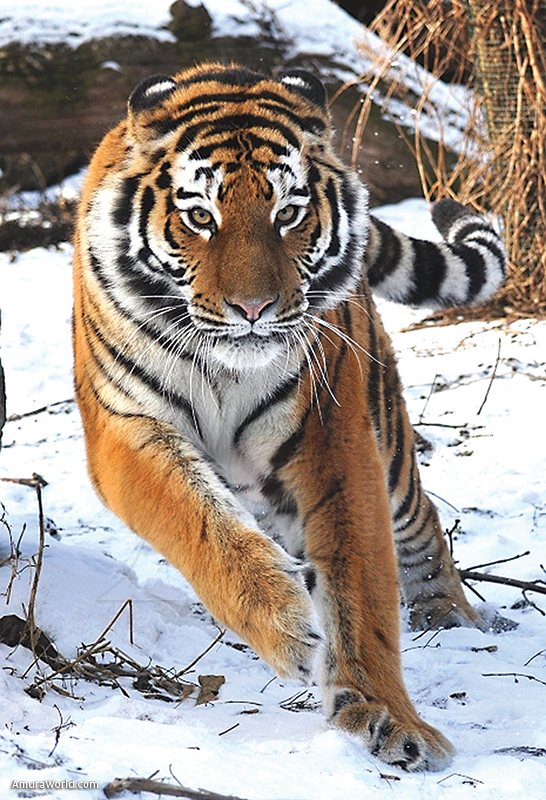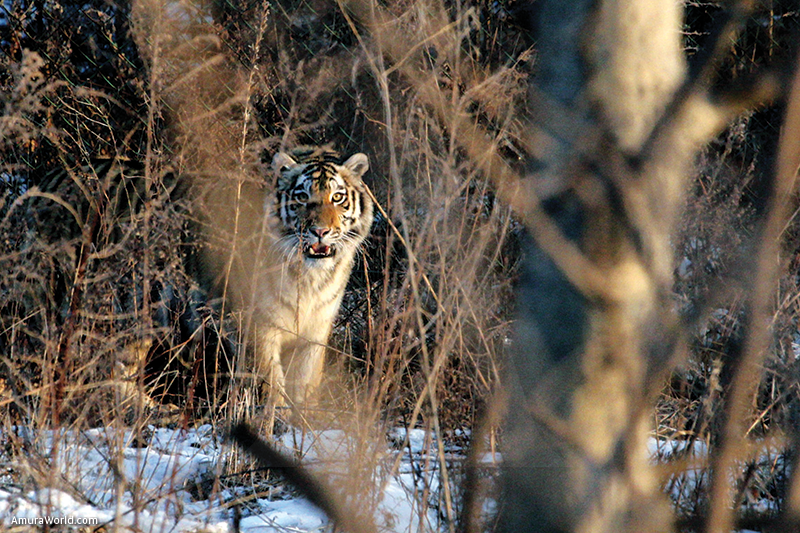Time of Tigers by John Goodrich diary
It was the 15th of December, 1998, and we were walking through the moonlit forest, the snow cracking under our feet, then, a growl was heard, like a faraway thunder. But, the soft ‘pop’ of a tranquilizer dart was heard and hit its target. Ten minutes later, the tigress Amur (which we called Nadia) was sleeping placidly.
Nadia was a tigress of the Amur species, also known as the Siberian tiger (Panthera tigris altaica, as it scientifically known). It is a subspecies of tiger whose ecological habitat is located in the extreme southeastern corner of Russia, in the region around the Amur River and the frontier with China.
Traditionally, it was considered the major tiger subspecies, and the largest of the felines, a family of carnivorous mammals that possess a svelte body, a sharp ear, and excellent sight. They are the stealthiest hunters.
Nadia died today, and with her, we lost an important animal to study. The tigress succumbed near the highway that provides access to hunters. It is clear that, in these roads, tigers are captured, or run over. Without these highways, the tigers can live to see their twilight years, and die of natural causes.
Nadia was one of more than 30 tigers that form part of our Russian-American project between the Hornocker Wildlife Institute and Conservancy Society, and the Zapovednik Sikhote-Alin Reserve.This biosphere reserve is located in the Primorsky Krai, Russia. It was founded on the 10th of February, 1935, to protect the populace from the sable. It is located at a watershed and slopes east of Sikhote-Alin, in the districts of Terneysky and Krasnoarmeysk. It measures 401,428 hectares, of which 2,900 are water, and the highest point is Glujomanka, reaching 1,598 meters in height.
The challenges
We studied Nadia for three years. We knew when and what she ate, with who she would mate, and when she would give birth. Similar information has been recovered by other felines, amongst them Olga, the tigress we analyzed.
We found the correlation between highways and tiger mortality rates. Analyzing the tigress and her offspring in three type of territories: remotes areas in Sikhote-Alin sans roads, areas surrounding Zapovednik, and zones with primary highways.
Paved, or compacted dirt roads permit the flow of traffic to move at high speeds, while secondary roads see only the flow of four-wheeled vehicles. We monitored the highways since 1992, and have followed 10 tigress, as well as 37 of their offspring.
The annual survival rate for an adult tigress is 100% in areas without roads. Areas with secondary roads lowers it to 89%, and those with highways diminishes the chances of survival to 55%. We found a similar pattern in their offspring: 90% survived in areas without roads, while only 40% did in areas with secondary roads.
More concerning still is that the highway between the provinces of Terney and Plastun that travels through Zapovednik. Despite receiving lesser traffic than other roads inside the tiger’s habitat, it is the most transited of roads inside our study area. Here, the reproduction cycles of the tigress Amur should be higher.
Lena, the first tigress in the area, had four offspring that have already been delivered to the Omaha zoo, in the United States, to prevent their deaths, given that their succumbed, and without human care, they would suffer the same fate.
Lena was substituted by Natasha, which we located in 1992, and tracked until 1997. During this time she roamed through an area without roads.
Another stripe on the tiger
In 2010, Natasha had four offspring. One was disposed by a predator, another died at a later date of unknown causes. In July, Natasha died; her two remaining offspring survived.
Before she moved to assume control of Nadia’s territory, Natasha roamed an area without roads, and had two litters, one with two cubs, and a second with three. All survived.
Maria Ivanna gave birth two five cubs, four of which dispersed. Maria Ivanna, like Natasha, moved to a new territory with one highway. While living in an area without roads, Natasha and Maria Ivanna, as well as 90% of their cubs, survived. Once they moved to areas with highways, both died.
A new approach
International groups finance the Tiger Inspection program to halt poaching. Many of the largest Zapovedniks have received their own foreign exchange to maintain their own teams against poaching.
If we can narrow access to hunters, we can increase not only the survival rates of tigers, but of their offspring, as well. Unnecessary highways, created by indiscriminate logging, could be dismantled, or used to supervise their habitats.
When a logging operation is concluded, the roads are maintained and provide easy access to hunters. In Russia, certified hunters normally have their own cabins, and come and go regardless of the existence of highways. This approach does not work in all cases, given that some roads are deemed too important by locals. But if we can close those breaches that are no longer useful, we can increase the survival rate of the species which both hunters and tigers depend on.
Checkpoints could be set up in some roads. This options gives citizens the opportunity to fish, collect wood, and berries. The guards can make sure that firearms are not being illegally transported.
The new roads need rigorous planning to avoid sensible areas. Often, the roads are paved without taking into consideration their environmental impact. If planning is not undertaken, soon there will be not wild area whatsoever left in the far east of Russia.
The only feasible plans for the conservation of the tiger will be those that improve the living conditions of the animals and the people. For the Amur tiger to thrive, people must cherish them.
Specifications
Popular Name
Amur tiger
Cientific Name
Panthera tigris
Class
Mammalia
Kind
Panthera
Family
Felidae
Feeding
Carnivorous
Gestation
105 days
Height
99 – 107 cm
Lenght
85 – 330 cm
Weight
85 – 310 kgs
Text: John Goodrich, Dale Miquelle, Linda Kerley and Evgeny Smirnov ± Photo: gdeon/ pinterest/ natgeo/ gio v/ phoenix




